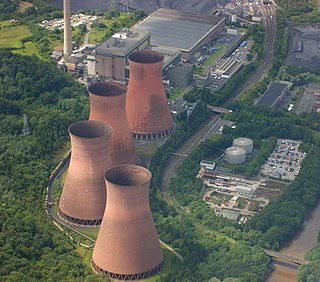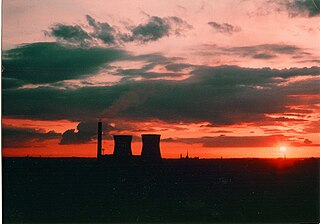
The Ironbridge power stations refers to two power stations that occupied a site on the banks of the River Severn at Buildwas in Shropshire, England. The Ironbridge B Power Station was operated by E.ON UK but the site is now owned by Haworth Group. The station stands near the Ironbridge Gorge World Heritage Site. Originally powered by coal, they were converted to use 100% biomass fuel. Ironbridge B Power Station stopped generating electricity on 20 November 2015, with the decommissioning process continuing into 2017. The main phase of the 27-month demolition process began at 11:00 GMT on 6 December 2019, commencing with the four cooling towers.

The Ferrybridge power stations were a series of three coal-fired power stations on the River Aire near Ferrybridge in West Yorkshire, England, in operation from 1927 to 2016 on a site next to the junction of the M62 and A1(M) motorways.

Drakelow Power Station refers to a series of three now decommissioned and demolished coal-fired power stations located 2.4 mi (3.9 km) south of Burton upon Trent, Staffordshire in the West Midlands of England, on the River Trent. However, the station was actually located in the county of Derbyshire, in the East Midlands. The power station was a distinguishable landmark of Burton, which is most famous for its breweries.

Portishead Power Station refers to a series of two coal and oil-fired power stations which operated in the dock area of Portishead in Somerset, South West England, between 1929 and 1982.

Agecroft power station was a coal-fired power station between the eastern bank of the Manchester, Bolton and Bury Canal and the western bank of the River Irwell at Pendlebury, near Manchester, England. It operated between 1925 and 1993, and was demolished in 1994. HM Prison Forest Bank has since been built on the site.

Blyth Power Station refers to a pair of now demolished coal-fired power stations, which were located on the Northumberland coast in North East England. The two stations were built alongside each other on a site near Cambois in Northumberland, on the northern bank of the River Blyth, between its tidal estuary and the North Sea. The stations took their name from the town of Blyth on the opposite bank of the estuary. Blyth A Power Station was built and opened first but had a smaller generating capacity than its sister station, Blyth B Power Station, which was built to its west four years later. The power stations' four large chimneys were a landmark of the Northumberland skyline for over 40 years; the A Station's two chimneys each stood at 140 metres (460 ft); the B Station's two chimneys were taller, at 170 metres (560 ft) each.
Rotherham power station was a coal-fired power station sited close to the centre of Rotherham in South Yorkshire.

Ince Power Station refers to two demolished power stations near Ellesmere Port in Cheshire, North West England.

Hams Hall Power Station refers to a series of three, now demolished coal-fired power stations, situated in Warwickshire in the West Midlands of England, 9 miles (14 km) northwest of Birmingham city centre.

Chadderton Power Station refers to a series of two coal-fired power stations, which were situated at Chadderton, Greater Manchester in North West England.

Doncaster Power Station refers to two coal-fired electricity generating stations situated in the centre of Doncaster in South Yorkshire, England. Doncaster A provided electricity to the town from 1900 to 1958, and the B station from 1953 to 1983.

Woolwich Power Station was a coal-fired power station on the south bank of the Thames at Woolwich.
Meaford Power Station was a coal-fired power station situated on the River Trent at Meaford near Stone in Staffordshire.
Bold Power Station refers to a series of two coal-fired power stations in Bold near St Helens, Merseyside, North West England. They were closed, decommissioned and demolished between 1981 and 1992, and a housing estate now occupies the site.

The Wakefield power stations refers to a series of two coal-fired power stations situated on the River Calder at Agbrigg south east of Wakefield, serving much of West Yorkshire. The first station on the site, Wakefield A power station was constructed for Wakefield Corporation in the late-1880s. A second station, Wakefield B power station, was brought into operation in the late-1940s and was decommissioned in 1991.

Kirkstall Power Station was a coal-fired unit opened in 1930, serving the city of Leeds, West Yorkshire, England.

Skelton Grange Power Station refers to two now-demolished coal fired power stations that served the city of Leeds and surrounding areas. They were located in the Stourton area of the city. The power stations were built in the early 1950s and early 1960s, taken out of use in 1983 and 1994 and subsequently dismantled but the associated 275 kV switching substation was retained and remains in use.

Poole Power Station was a coal-fired power station located in Hamworthy, Poole, in Dorset. Its 325 ft tall twin chimneys were prominent landmarks and it was the tallest building in Dorset until its partial demolition in 1993.

Huncoat Power Station was located in Huncoat near Accrington, Lancashire. It was a 150 MW, coal-fired, electricity generating station in operation from 1952 to 1984. It has since been demolished. Huncoat power station replaced the earlier Accrington power station that had supplied electricity to the town since 1900.
The Thornhill power station generated and supplied electricity to the town of Dewsbury and the wider regional area from 1902 to 1982, and again from 1998. The first generating station on the site was owned and operated by the Yorkshire Electric Power Company. Following nationalisation of the British electricity supply industry in 1948 Thornhill power station was operated by a succession of state owned bodies. The power station was redeveloped with new plant in 1915, 1925, 1932–37 and 1950–54. The coal-fired steam station was decommissioned in 1982, and was subsequently demolished. A gas turbine power station on the site was commissioned in 1998.

















